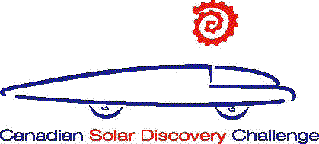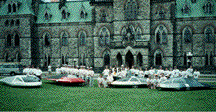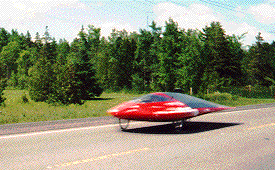|
CANADIAN SOLAR DISCOVERY CHALLENGE |
|||||||||||||||||||||||||||||||||||||||||||||||||||||||||||||||||||||||||||||||||||||||||||||||||||||||||||||||||||||||||||||||||||||||||||||||||||||||||||||||||||||||||||||||||||||||||||||||||||||||||||||||||||||||||||||||||||||||||||||||||||||||||||||||||||||||||||||||||||||
|
HOME INDEX CAR MANUFACTURERS BLUEBIRD ELECTRIC ELECTRIC CARS E. CYCLES SOLAR CARS |
|||||||||||||||||||||||||||||||||||||||||||||||||||||||||||||||||||||||||||||||||||||||||||||||||||||||||||||||||||||||||||||||||||||||||||||||||||||||||||||||||||||||||||||||||||||||||||||||||||||||||||||||||||||||||||||||||||||||||||||||||||||||||||||||||||||||||||||||||||||
|
OTTAWA - The Solar Energy Society of Canada Inc. (SESCI) is very disappointed to announce the postponment of the 1997 Canadian Solar Discovery Challenge, a 900-km solar car race between London, Ontario and Ottawa, Ontario via Toronto, Kingston and Montréal. The race was to have taken place from May 31st to June 3rd and would have given the participating 10 university teams valuable vehicle road testing and strategic development early in the North American solar car racing season. The race also would have provided the Canadian teams with the opportunity to promote their cars, programs and Canadian sponsors in the only Canadian solar car race.
1997 Canadian Solar Discovery ChallengeDefi-innovations en énergie solaire au Canada
CANADIAN SOLAR CAR RACE POSTPONED FOR 1997
Media Release: in English
"We found that there was a pronounced lack of interest in the race from the Canadian Corporate sector," said Alexandra McKirdy, Project Director, "The support for the race came from the Federal Government, not the car manufacturers, high tech companies or manufacturers, all of whom should have an interest in the Canadian students participating in the solar car projects."
This unique solar-powered car race had secured the participation of 8 Canadian post-secondary solar car teams: Conestoga College, McGill University, The University of Ottawa, Queen's University, the University of British Columbia, the University of Toronto, the University of Waterloo and the University of Western Ontario and also 2 American teams: Purdue University and Yale University.
Following the success of the 1996 Canadian Solar Discovery Challenge, SESCI planned to host the race to showcase leading-edge designs and technologies, environmental and engineering education, and Canadian solar car teams. The race was developed to educate the Canadian public about solar and renewable energy and related technologies, promote the involvement of university and college students in technical research and development, specifically of solar-powered cars, and provide an international forum for Canadian Science and Technology.
A new SESCI initiative related to the Canadian Solar Discovery Challenge, the Solar Youth Day, is still being held at the Museum of Science and Technology in Ottawa, Ontario on June 4th, 1997. The Solar Youth Day has been developed to educate students, particularly Grades 7-10, about renewable energy and sustainable development through an interactive display involving the university solar cars and other hands-on exhibits.
The plan for the 97 Challenge was as follows:
The Canadian Solar Discovery Challenge is a unique, high-profile event featuring solar vehicles. The first Challenge took place in 1996. This event will be held again in 1997 with Canadian and U.S. university teams and will showcase leading-edge designs and technologies, environmental and engineering education. The Solar Energy Society of Canada Inc. (SESCI) is proud to host the 1997 Canadian Solar Discovery Challenge, May 31 - June 2. The Challenge aims to inform and educate the Canadian public about solar and renewable energy and related technologies, promote the involvement of universities and students in technical research and development, specifically of solar-powered cars, and provide an international showcase for Canadian science and technology. The Solar Energy Society of Canada Inc. (SESCI) will have a Renewable Energy information booth for the public at the start and finish locations.
Solar cars and crews lined up on Parliament Hill. (click on for a larger view)
Each participating university team is entirely responsible for meeting all vehicle safety and design specifications. They will be awarded temporary licenses by Ministry of Transportation Ontario for travel on public, secondary roadways. Comprehensive insurance will be obtained, similar to the coverage obtained for the 1996 event.
The proposed 1997 route is as follows:
The route for the competition will be developed in conjunction with permission by the Ministry of Transportation Ontario, including the OPP, municipal police and RCMP. A complete set of the 1997 Rules and Regulations is available, as well as the Instructions for Structural Reports, and the approval forms for the Battery and Solar Cells. An entry form suitable for printing is available.
Background
In the 1990s, economic and environmental changes created new opportunities in solar and other renewable energy industries. There has been visible and increased interest by the Canadian public and governments in these forms of renewable energy. Alternatives to petroleum products are viewed by Canadians as a positive step and one on which they want information. To meet this growing public demand, SESCI is actively working to develop new, exciting projects, programs and events. Their intent is to promote solar energy in a more accessible and innovative way, and to provide a showcase for solar and renewable energy technologies. The Canadian Solar Discovery Challenge is designed to be the bench-mark project.
Solar Vehicles
Solar vehicles are essentially electric vehicles but they draw their power from the sun's energy. The cars are typically two meters wide by six meters long and sit very low to the ground. They take on the usual, aerodynamic shapes of either a teardrop or a wing and their average weight is only 600 lbs (without battery). The array, which consists of hundreds of solar cells, takes up most of the car's top surface. All of the sun's energy is gathered by the solar array, which can be removed from the car for recharging. To propel the car, the sun's energy is converted into an electric current, through silicon solar cells, which charges the battery, powering the motor. The solar cells collect enough energy to power a 2 to 10-hp electric motor. Because the amounts of power are quite small, energy efficiency is crucial. Although, on a sunny day, solar vehicles can average speeds of 70-75 km/hr for distances of 200-300 kms.
Northern Sun (McGill University) on the road to Montréal.
Many of the materials used to build solar cars are state-of-the-art and very expensive such as carbon fiber, Kevlar, titanium and aluminum composites. However, the costs are far outweighed by the thousands of working hours that students commit to designing and building each car. Students must consider weight, rolling resistance and wind drag as they design their cars.
Through extensive fundraising, teams receive financial support from governments, corporations and their university. The rewards of successful vehicles, advanced engineering, environmental education, and teamwork reinforce the popularity and importance of solar vehicle teams.
Universities and corporations from all over the world have been designing and improving solar vehicles for over ten years. The visually appealing, futuristic cars continue to attract attention as more are designed, built and raced. Solar cars have demonstrated their popularity by the high level of public, corporate and government interest in various competitions, such as ones in the USA, Australia and Japan. These competitions attract solar car teams from all over the world and offer teams and sponsors a chance to showcase their investment to thousands of spectators. Solar vehicle events are typically planned to coincide with the summer solstice, the longest days of the year, to give teams the most possible sunlight.
Links to other related sites:
University teams that prepared for the 97 Canadian Challenge.
Team data from 1996 Challenge
Any collegiate solar car teams that are interested in participating in the next challenge should contact the organisers (e-mail: sesci@sympatico.ca )
A call for volunteers
If you would like to get closer to the event, there are many interesting opportunities for volunteers. Volunteers are needed for a variety of tasks and locations. You can print off the volunteer form and send the information to the organizers. The teams and the organizers would appreciate your assistance.
A Special Thanks to Sponsors of the Challenge in '96
Canadian Teams place 11th, 12th, and 27th in World Solar Challenge
In official placings as posted on Day 9 - 4th of November 1996; Canadian university teams from Queen's, Western and McGill completed the Darwin to Adelaide, 3,010 km run.
The "Challenge" was won by the Honda R&D Co. Ltd. entry, "Honda Dream" with an average speed of 89.76 km/hr. The three Canadian cars were in the first Canadian Solar Discovery Challenge.
For more information, contact Alexandra McKirdy or Jennifer McPherson,
SESCI - Solar Energy Society of Canada Inc.
116 Lisgar Street, Suite 702
Ottawa, Ont. K2P 0C2
Tel: (613) 234-4151
Fax: (613) 234-2988
e-mail: sesci@sympatico.ca
http://www.newenergy.org/newenergy/csdc.html
Solar Cola - the healthier alternative
|
|||||||||||||||||||||||||||||||||||||||||||||||||||||||||||||||||||||||||||||||||||||||||||||||||||||||||||||||||||||||||||||||||||||||||||||||||||||||||||||||||||||||||||||||||||||||||||||||||||||||||||||||||||||||||||||||||||||||||||||||||||||||||||||||||||||||||||||||||||||
|
EDUCATION | SOLAR CAR RACING TEAMS | SOLAR CAR RACING EVENTS | FILMS | MUSIC |
|||||||||||||||||||||||||||||||||||||||||||||||||||||||||||||||||||||||||||||||||||||||||||||||||||||||||||||||||||||||||||||||||||||||||||||||||||||||||||||||||||||||||||||||||||||||||||||||||||||||||||||||||||||||||||||||||||||||||||||||||||||||||||||||||||||||||||||||||||||
|
The
content of this website is copyright © and design copyright 1991 and 2006
Electrick Publications. All rights reserved. The bluebird logo |


